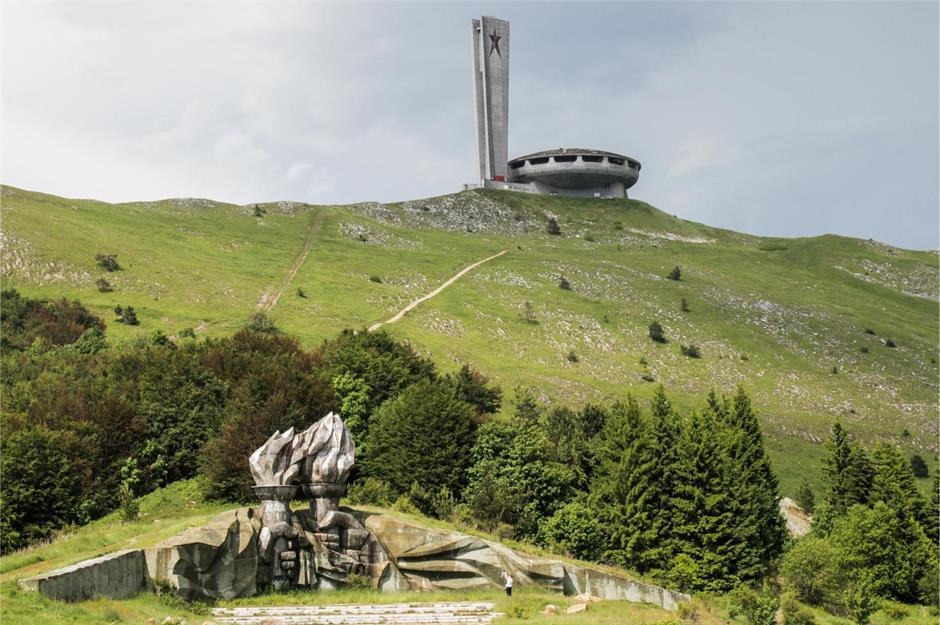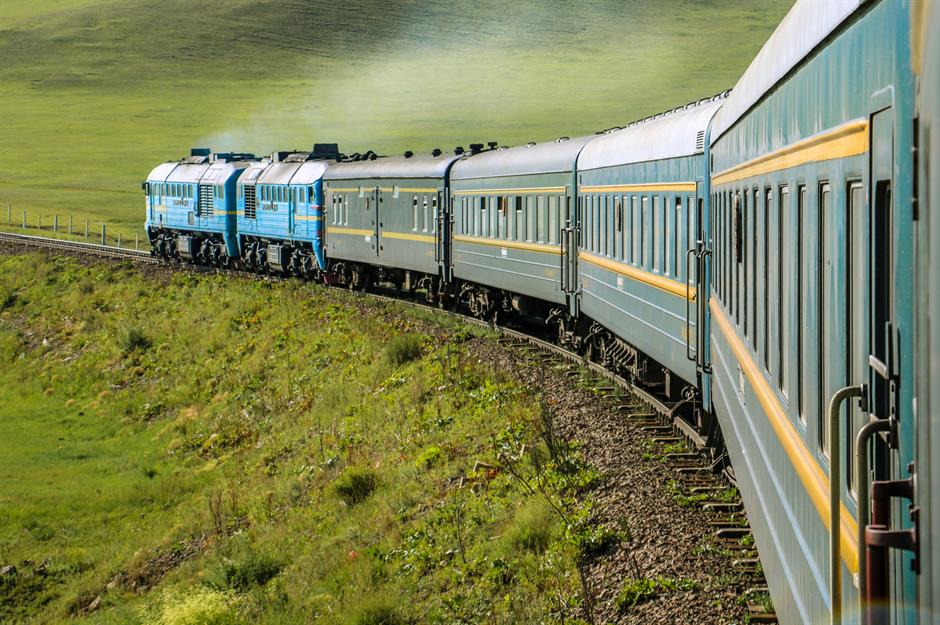From cars to bunkers: the world's striking communist remains
Trabants, trains, tombs and… a UFO
Overnight trains, Russia and Eastern Europe
Aboard an overnight train in Eastern Europe or the famous Trans-Siberian Railway in Russia travellers are transported back in time. Most of the carriages have been rattling along the rails since the Soviet era.
Overnight trains, Russia and Eastern Europe
Comfort wasn't necessarily an afterthought in Soviet times, with passengers still able to enjoy a reasonable night's sleep. However, it's not the most private train journey as some carriages don't have walls around the bunk beds, making it a very communal experience.The
Overnight trains, Russia and Eastern Europe
The rail networks haven't had much of an upgrade since the communist era. Aside from being shaken around all night, passengers travelling between Bucharest and Moldova might be thrown out of bed after midnight, as engineers have to remove and replace the wheels underneath the train to fit on the broader gauge rail lines of Romania's eastern neighbour. It's a challenge that has existed for decades as Romania decided not to change to the width of the Soviet rail lines under communism.
Classic cars, Cuba
Classic cars are synonymous with Havana and demonstrate just how much communism has affected Cuba until today. For several decades, the socialist government led by Fidel Castro only allowed pre-revolutionary cars to be bought and sold within the country. It's why these days, there are about 60,000 cars from 1959 or earlier on Cuban roads – and visitors can enjoy touring in these old vehicles.
Classic cars, Cuba
Several tour operators offer chauffeured two- to three-hour rides across the capital. Guests can soak in the sights, such as Revolution Square, the National Capitol Building and the shore road Malecón in true style.
Bunkers, Albania
In Albania, concrete bunkers from the 1960s to 1980s are a ubiquitous sight. They were built during the communist government of Enver Hoxha, who saw his country at threat from neighbouring, rival regimes. After the fall of the Iron Curtain, the bunkers were left abandoned and many are now derelict. Some of them have since been turned into museums, animal shelters and even quirky accommodations.
Bunkers, Albania
The bunkers can be found in every corner of the country, from the mountains to the coast, with an average of 14.7 structures in every square mile. They were never actually used for defensive purposes and remain one of the most expensive and pointless government projects in world history.
Bunkers, Albania
Visitors to Albania can peek into the converted Bunk’Art (pictured), a museum and art gallery in the capital, Tirana. Rooms within its many tunnels have been staged to look like they would have during Hoxha's rule.
More of the world's most interesting underground attractions
Soviet statue graveyards, Eastern Europe
Soviet statue graveyards, Eastern Europe
In Estonia, one of the countries that regained independence from the Soviets with the fall of the Iron Curtain, the unloved heads of Vladimir Lenin and Joseph Stalin are on display together behind the Estonian History Museum near Tallinn. Other statues are missing hands or other parts.
Soviet statue graveyards, Eastern Europe
Under construction for some years, there's now a park filled with the Soviet sculptures behind the museum's Maarjamäe Palace, which you can walk around and come face-to-face with some of history's most notorious characters.
Soviet statue graveyards, Eastern Europe
Statues of Lenin, Marx and Stalin can also be found in Memento Park in Budapest. The statue graveyard houses 42 sculptures that were removed from the Hungarian capital and together they demonstrate how powerful the dictatorship must once have been.
Soviet statue graveyards, Eastern Europe
Lenin, Lenin and Lenin again. These busts of the Soviet leader can be found in Grūtas Park in Lithuania, which features 86 Soviet-era sculptures. The park is divided into several areas, each one dedicated to a different communist leader.
These are the world's most jaw-dropping statues and sculptures
Bodies of communist leaders: Vladimir Lenin, Moscow, Russia
Bodies of communist leaders: Ho Chi Minh, Hanoi, Vietnam
The body of Vietnamese revolutionary leader Ho Chi Minh is also on public display – despite his will to be cremated after his death. The granite mausoleum in Hanoi was modelled after Lenin's tomb in Moscow. Streams of people usually queue each day, sometimes for hours, to pass by his body in silence.
Bodies of communist leaders: Mao Zedong, Beijing, China
For decades, Mao Zedong had absolute power over millions of people. After his death in 1976, the Chairman of China's body now lies embalmed in a crystal coffin draped in a red flag (also against his will). Thousands of Chinese people continue to pay their respects in the mausoleum at Tiananmen Square (entrance is free).
Tombs of communist leaders: Karl Marx, London, UK
Even though the body of Karl Marx wasn't preserved, his tomb in Highgate Cemetery in north London has become one of the most recognisable in the world, thanks to the huge, bearded bust on top. The final line of The Communist Manifesto is etched into the marble, which is now heritage-listed. Ironically, Marx is buried next to philosopher Herbert Spencer, who coined the phrase “survival of the fittest” and stood against everything Marx dreamed of.
Tombs of communist leaders: Josip Broz Tito, Belgrade, Serbia
Tombs of communist leaders: Fidel Castro, Santiago de Cuba, Cuba
One of the most recent deaths in communist leadership, Fidel Castro's ashes were laid in the Santa Ifigenia Cemetery in Santiago de Cuba in 2016. With its big granite boulder and a plaque saying no more than 'Fidel', the tomb of the Cuban revolutionary seems simple, but it's still a tourist hotspot.
Trabants, Berlin/Dresden, Germany
Symbolic of the German Democratic Republic (GDR), the quirky Trabant was the pride of the communist regime in East Germany from the 1950s until the end of its production – and the fall of the bloc – in the early 1990s. Lovingly nicknamed 'Trabi' in German, the iconic car, whose design wasn't changed for decades, can still be seen on German roads.
Trabants, Berlin/Dresden, Germany
Nowadays, visitors to Berlin and Dresden can get behind the wheel of a Trabant. So-called Trabi safaris are available; in Berlin, for example, the tour takes tourists right through the centre, past the Brandenburg Gate, the Reichstag and the remains of the Berlin Wall.
Trabants, Berlin/Dresden, Germany
Visitors can cruise the streets in the model of their choice, driving the two-stroke engines themselves as part of a Trabi caravan led by a guide. Information about the city and the sights are broadcast in different languages through the radio in each car.
Trabants, Berlin/Dresden, Germany
Less is more when it comes to the design of the Trabi – the ride can be very bumpy. Also, some of the models had no indicator, no fuel gauge and no rear seat belts. This picture shows the refurbished interior of a Trabant 600 (P6) from 1963.
Ignalina Nuclear Power Plant, Visaginas Municipality, Lithuania
Fans of the HBO hit mini-series Chernobyl will recognise the look of this nuclear reactor. Constructed a year after the catastrophe in Ukraine, the Ignalina Nuclear Power Plant (INPP) in Lithuania is a carbon copy of the reactor in Chernobyl. Only an hour and a half's drive from the country's capital Vilnius, the reactor and the town of Visaginas (the equivalent of Pripyat) were used to film pre-explosion and clean up scenes, including the scenes with divers and miners.
Ignalina Nuclear Power Plant, Visaginas Municipality, Lithuania
A culmination of the Soviet Union's nuclear power programme, the RBMK (high power channel-type) reactors were cheap and simple enough to build in large numbers but extraordinarily powerful for their size. There are currently around 2,000 people working at the Ignalina plant – only about a third of the number of workers that the reactor employed when it was in full operation (the first block of INPP was decommissioned in 2004, the second in 2009). The reactor will be fully dismantled by 2038.
Ignalina Nuclear Power Plant, Visaginas Municipality, Lithuania
Open for visitors, excursions have to be booked in advance and last around one hour. You'll see parts of the old power plant's layout and spent nuclear fuel storage containers before learning all about the decommissioning process and where nuclear waste will be disposed of in future.
North Korea
Probably the most secretive country on the planet, North Korea is arguably the last real bastion of communism. As of July 2023, the country remains closed to outsiders due to outbreaks of COVID-19, but before the pandemic tourists from abroad had the opportunity to join an official tour with chaperones appointed by the government. Activities included admiring the tall bronze statues of the former almighty leaders of the 'hermit kingdom', Kim Il-sung (left) and Kim Jong-il, in the capital Pyongyang. Photos could only be taken from the front – any other angle was considered unflattering and not permitted.
North Korea
The chaperones also showed off their modern subway in Pyongyang, which visitors were once allowed to ride, so long as they were accompanied. Speaking to any local on the train was strictly prohibited, though. Also, foreigners could only travel between two stations.
North Korea
When (or if) borders reopen to outsiders, visitors might be fortunate enough to view one of the country's biggest spectacles. Every few years (the schedule is rather sporadic), a giant mass dance takes place in Pyongyang May Day Stadium. The Arirang Mass Games (pictured) see hundreds of schoolchildren and adults move in synchronised precision to symbolise the unity of communism.
North Korea
Speaking of oddities, North Korean amusement parks like this one in Pyongyang used to have a rather outlandish attraction. Between carousels and duck-fishing, a popular activity was shooting at pictures of American soldiers with toy guns – but many have now been replaced by 'friendlier' targets.
Check out these eerie abandoned theme parks around the world
North Korea
Frequently earning a spot on lists of the world's ugliest buildings, the pyramid-shaped Ryugyong Hotel in Pyongyang (pictured) is said to be the tallest unoccupied building on the planet and has been unfinished for a long time. It is still not a place foreign visitors are permitted to stay – or anyone, for that matter, as the hotel has never been opened.
Buzludzha Monument, Shipka, Bulgaria
Buzludzha Monument, Shipka, Bulgaria
Buzludzha Monument, Shipka, Bulgaria
Decades of neglect have taken its toll inside the monument. The dome is now derelict and the huge is auditorium covered with debris. The eerie sight has become a popular place for graffiti artists and has featured in films and music videos.
Buzludzha Monument, Shipka, Bulgaria
In recent times, the authorities have restricted access to the abandoned building. But visitors can still drive up the mountain road between Kazanlak and Shipka, and stroll around its base. The views from the peak are pretty spectacular too, that is, if you can stop looking at the odd giant grey thing next to you. There's talk of it eventually re-opening as a museum, but no concrete plans have been made.
Now discover the European hotels that once thronged with tourists – but now lie abandoned

